Shapes and Patterns Class 2 Notes Maths
What are Shapes?
In Mathematics, shapes define the outline or the boundary of an object. The shapes can be classified into different types based on their properties. In general, the shapes are closed by an outline or boundary, which is made up of points, lines and curves, and so on.
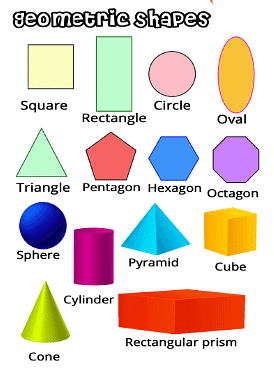
Types of Shapes
- Plane shapes are known as 2D shapes (Two dimensional shapes).
- Solid shapes are called 3D shapes (Three dimensional shapes).
➤ 2D Shapes
Shapes like circle, triangle, square, rectangle and oval are called flat or plane shapes.
- Triangle: A triangle has 3 corners and 3 sides. The sides may or may not be equal.
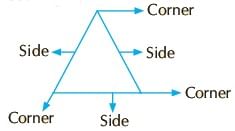
- Square: A square has 4 corners and 4 sides. All its sides are equal.
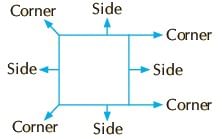
- Rectangle: A rectangle has 4 corners and 4 sides. Its opposite sides are equal.
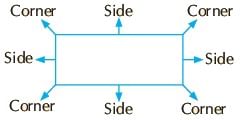
- Circle: A circle has no corners and no sides.

- Oval: An oval also has no corners and no sides.

➤ 3D Shapes
Shapes like cube, cuboid, cone, sphere and cylinder are called solid shapes.
- Cube: A cube has 6 faces, 12 edges and 8 corners. All the faces of a cube are equal.

- Cuboid: A cuboid has 6 faces, 12 edges and 8 corners. Opposite faces of a cuboid are equal.

- Sphere: A sphere has 1 face, 0 edges and 0 corners.

- Cone: A cone has 2 faces, 1 edge and 1 corner.
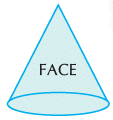
- Cylinder: A cylinder has 3 faces, 2 edges and 0 corners.

Point
- It is like a dot. A point has no shape, breadth, length or height.
- It is always named by a capital letter.
- For example: Point P.
- A line is formed by placing many points next to each other
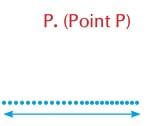
Straight and Cureved Lines
Hold a thread and stretch it tightly, you get a straight line. Now if you hold it loosely, you get a curved line. Straight line is a line in which both the ends never meet each other. Straight lines may be
This is a scale. We use it to draw straight lines.

Curved line is a line in which both ends may or may not meet each other.
Patterns
A pattern is a series of items placed in a certain order. There are patterns all around us. Patterns add beauty to the objects.
Kinds of Patterns - Patterns are of different kinds – repeating patterns and increasing or decreasing patterns.
1. Repeating Pattern In repeating pattern same things appear again and again.

2. Increasing Pattern - In increasing pattern things increase in size or number.

3. Decreasing Pattern - In decreasing pattern things decrease in size or number.
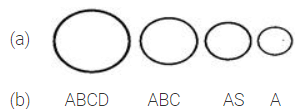
Number Patterns
- Various patterns can be made by numbers.
- We can guess the next number in a pattern.
Examples:
Increasing Pattern:
In increasing pattern numbers increase in a certain manner, for example.

In the above example numbers are increasing by two.
Historical Preview - Geometric patterns were the great source of decoration in Islamic art which include calligraphy and vegetal patterns.
Decreasing Pattern:
In decreasing pattern numbers decrease in a certain manner, for example.

In the above example numbers are decreasing by one.
Repeating Pattern:
In repeating pattern numbers are repeated in a certain manner, for example.

In the above example 1 and 2 are appearing one by one.
Shape Patterns
- We can make a pattern with shapes.
- In shape pattern shapes are repeated in a particular manner.
Examples:
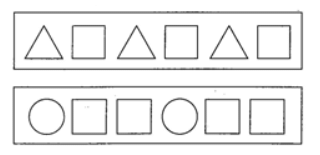
Patterns given above are based on repetition of shapes.
Turning Shapes
A shape can be turned up, down, left, right again and again. We can see turning shape patterns in art and fabrics.
Examples:
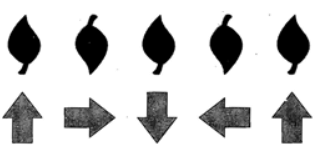
Tiles Pattern
The tiles which cover the floor of your house creates a pattern. The method of putting the tiles together without gaps is called tessellation.
Examples:

Amazing Facts
- Patterns are found in the natural world.
- Natural patterns include trees, waves, symmetries and stripes. We can see beautiful patterns on the skin of various animals, like Tiger, Zebra, Leopard etc.
Thumb Patterns
Patterns which are made with the help of thumb and fingers are called thumb patterns.
Examples:
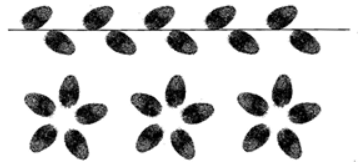
|
17 videos|138 docs|19 tests
|
FAQs on Shapes and Patterns Class 2 Notes Maths
| 1. What are some common shapes found in everyday objects? |  |
| 2. How can children learn about shapes and patterns in a fun and interactive way? |  |
| 3. Why is it important for young children to learn about shapes and patterns? |  |
| 4. How can teachers incorporate shapes and patterns into their lesson plans for young students? |  |
| 5. What are some ways parents can reinforce their child's learning of shapes and patterns at home? |  |

















